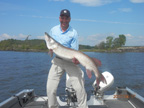
Posts: 3508
Location: Elk River, Minnesota | Hiya,
Shep has hit it well. With some props (most notably mercury props), the vent size can be changed with different inserts in the hub. So...to go off of Shep's information, if the vent holes are too big, the prop will slip like crazy until you get up to mid RPMs, and can be a real bear in rougher conditions....so it is possible that around 3000 or so, you can have problems with the prop grabbing and slipping, thus the rise and fall of the bow. Usually after that, the exhaust gasses are moving too fast to enter the vent holes, thus the prop grabs as it should. That 3000 mark is where many of the grab issues have when the rig is at an optimum set-up. Most times, a smaller vent hole is desired.
Many times, the rise and fall of the bow happens when you are above mid range, but not at full throttle as slower speeds usually allows for lest venting of the blades, increasing grab to the point the prop can't hold it. If you increase rpms, it can settle down. In most cases such as this, a little trim down to keep the bow down helps as the prop is working more to lift the stern at that point. Usually doesn't take much to settle it down.
Trim is a constantly changing part of working your boat. Make a moderate turn, and you will find trimming down a long way is helpful to let the boat carve the turn...especially at high motor mounting heights. Slow down, trim down as well for the reasons mentioned above. My thumb is constantly on the trim and adjusting...especially on long runs with changing condtions as I traverse the lake....
The goofy thing in all of this is boats can be very finicky with the prop that works best for the rig. With my particular motor, I have been quite fortunate in that I was able to dial in quickly, but my previous motor took some time to find the prop that worked best. Ebay was my best friend for a couple of summers, buying and selling as I found props that could potentially work, and all I was out was the cost of shipping.
If you do end up purchasing another prop, it can be beneficial to go to a dealer that has a blue-prop program where you can try different props in different pitches. Usually, though this is tied to the purchase of a prop to begin with, which is where you can incur a $350 to $400 or more cost, but you get the benefit of the demo props to try. Find the one that works, and you are all set.
Steve |





